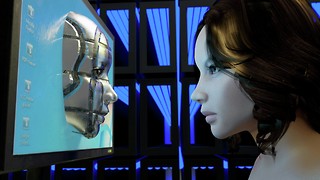Visual Arts: Bauhaus: Art as Life
The Barbican Centre, London

The Bauhausian school of art emerged in a euphoric reconstruction blaze, in post World War I Germany, and came to represent the single most influential design style of the modernist era. The vision of architect Walter Gropius, it channelled the philosophies of architects, artists and industrialists into one working, living, artistic ideal where the aesthetics and ergonomics of design were intertwined with the creative lifestyles of its residents. Modernist architecture was formulated at its most compelling: confident, optimistic, and fiercely proud of a new post-war utopia.
Art as Life represents the most exhaustive and complete collation of the Bauhaus since 1968. The richness of original material on display, photography, film, furniture, sculpture, theatre, textiles, is overwhelming. Cast in a Bauhausian aesthetic of light, space and shadow, the exhibits meander through various elements of the art school’s life from its origins in 1919 Weimar, its architectural explorations and consolidations in Dessau, its furniture design, stage workshops, social parties and photomontages.

The effect of such a comprehensive documentation of the Bauhaus is mixed. On the one hand the works are powerfully arranged, and their depth and number go some way to demonstrating the profound reach and influence of the Bauhaus. Marianne Brandt’s metal tea service and Wilhelm Wagenfeld’s table lamp sit alongside the geometrically austere and inventive photographs of spectacular Bauhausian parties; models of the Bauhaus building in Dessau, which crystallised all modernist ideas of space, form and construction, seamlessly move on to controlled depictions of Osker Schlemmer’s choreography.
The clarity and rationality of Bauhausian graphic design are perfectly encapsulated in the shadows and light of the spacious exhibition setting. Carefully structured visual displays carve a balance between the work, people and living which made up the Bauhaus school, and provide an overarching understanding of how inventive ideas bounced between communal work, life and play.

But there is some disconnect in the continuously meticulous and polished monologue of outpourings which are portrayed here. For all the turbulations and geographical wanderings of the Bauhausian School’s 14 year existence, during which time it moved from Weimar to Dessau to Berlin and finally to a global diaspora spearheaded by the New Bauhaus in Chicago, Art as Life displays only a fixed glossy sheen.
Perhaps because of the abundant, formulaic and geometrically perfect documentation, the intimate realities of the Bauhaus art school as a living breathing organism of creative outpourings are suffocated. The Bauhausian school was as much about the parties, sex and play as it was about the serious output of design. It represented a dramatic new utopian vision and an intensely exciting space for communal creativity. I wanted to feel the zeal and ferocity of this new creative ideal and the drama and excitement which accompanied it. Instead I saw only the machinations of the ideal, without its essence.
Midway through the course of the exhibition the intense gazes of the artists stared out of the bare walls, acting as a reminder of the human souls who filled the art school with their inventive ideals. But, save these haunting portraits, there was little room for personal intimacy with the artists – Art as Life was a gratifying and carefully orchestrated performance which radiated perfection, and ignored the human traumas. Instead of understanding the creative spasms of these artists, their hopes, fears, traumas, failings, I left only with an intimate knowledge of their projections, and no picture of the organic flux of life which underpinned their work and which would ultimately have been more fulfilling. Any sense of fun and inventive mischief is swallowed by the self-importance of the subject matter and no thrills or colour break up the austere setting to remind us that this bright revolution was radically dramatic.
If Bauhaus is utopia then Art as Life left a feeling that utopia is a heartless mannequin; and that’s an ideal that no one, least of all the Bauhausians, can subscribe to.
Bauhaus: Art as Life is running at The Barbican Centre from 3rd May – 12th August
 Features / The community Cambridge accommodation creates (and doesn’t)9 August 2025
Features / The community Cambridge accommodation creates (and doesn’t)9 August 2025 Comment / Are degrees still worth it?4 August 2025
Comment / Are degrees still worth it?4 August 2025 Sport / ‘A full-time job with overtime’: should disparities change the way we approach Bumps?6 August 2025
Sport / ‘A full-time job with overtime’: should disparities change the way we approach Bumps?6 August 2025 Lifestyle / An ode to college accommodation11 August 2025
Lifestyle / An ode to college accommodation11 August 2025 News / News in Brief: Streets, suns, and TV stars10 August 2025
News / News in Brief: Streets, suns, and TV stars10 August 2025









